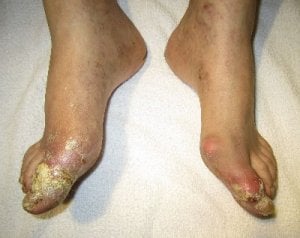Gout or Bunions for Arthritis Sufferers describes differences between bunions and gout. So if you have a painful big toe, you can see if it is gout or not.
Gout or Bunions Audience
I wrote Gout or Bunions for GoutPal Arthritis Sufferers. Because they need to consider if they have gout or a different type of arthritis. So if you’re not sure which type of gout sufferer you are, please read Questions for Gout Sufferers.
Difference between Gout and Bunion
In a nutshell, gout is caused by our immune system reacting to an “invasion” of uric acid crystals. Whereas a bunion is our bodies attempt to repair damage caused by physical pressure.
Gout can affect any joint. But it frequently starts in the big toe. Because that is a large joint that is often colder and at the lowest point. So a combination of gravity, slower blood flow, and lower temperature make the big toe first joint the most likely place for gout to start in most people. However, this is heavily influenced by personal habits. For instance, I got gout in my ankle first because my job entailed a lot of driving. Another common characteristic of gout is that it strikes without warning. Then you reach maximum pain within a day. Followed by a week or two of gradual lessening pain.
Comparing gout with bunions, we see a different profile. Because bunions only affect the big toe. But the little toe can also be similarly affected by what is called a bunionette, or tailor’s bunion. Bunion pain is usually progressive over several days or weeks. Also, it often starts with the big toe bending upwards or towards the second toe.
The main reason why bunions are confused with gout is that both can have red skin and painful swelling. But before we consider the best way to tell them apart, let’s look at other big toe problems.
Other causes of Swollen Big Toe
As well as bunion, gout has been confused with several diseases that cause big toe pain.[1]. Here Chou and colleagues list:
- Hallux rigidus – osteoarthritis of the big toe, literally Stiff Big Toe.
- Hallux valgus – bunion, as I describe above.
- Sesamoiditis – inflammation of a sesamoid bone, normally in the foot. (See sesamoiditis vs gout feedback below.)
- Stress fractures – caused by injury from activities or physical contact with hard objects.
Also, they consider general bone and cartilage defects. As well as gout.
Stress fractures, osteochondral defects, and gout are other causes of toe pain. X-rays are essential for accurate diagnosis. Nonoperative measures can reduce pain, but surgery is an option for recalcitrant cases.
Later, Zanni and colleagues extend the list[2]:
Common mechanical problems include hammertoe, arthritis, bunions, and metatarsalgia. Disease-induced conditions include onychomycosis, athlete’s foot, plantar warts, gout, and diabetes. Treatment is case-specific and often involves multiple interventions, including lifestyle changes.
See Uric Acid and Bunions for pointers to avoid confusion with bunions and bunion joints.

Your Gout or Bunions
If you have a red, swollen big toe, you need to find out if it is bunion, gout, or some other form of arthritis. Because, as these studies show, treatment is very different depending on what you are actually suffering from. So Chou recommends x-rays. But if gout is suspected, I suggest a uric acid blood test is essential. Also, if possible, you should get a rheumatologist to draw fluid from the affected joint. Because the presence of uric acid crystals is a definitive test for gout. But an absence of crystals does not rule out gout.
Finally, you might find that you suffer from both gout and bunion. Because swelling from gouty tophi can cause pressure on the joint leading to a bunion. However, if uric acid is treated successfully, that might resolve the bunion problem at the same time.
In conclusion, whenever gout diagnosis is doubtful, you should consult a rheumatologist. Because there are several tests that can differentiate between different causes of a swollen red big toe. But most of these tests are not suitable for primary care physicians.
If you are still not sure what to do next, ask fellow sufferers about your swollen red toes.
Leave Gout or Bunions to read GoutPal Plan for Arthritis Sufferers
Gout or Bunions Comments
GoutPal visitor responses and associated research include:
Sesamoiditis versus Gout
There have been several discussions in the gout forum about sesamoids. They continue to attract lots of interest. Though gout sufferer involvement is quite low. I assume this is part of a growing recognition that gout can cause sesamoiditis. Note that I say “growing recognition”. Because what was described as “rare” in 1995/7 became “uncommon” by 2004[3-8].
Anyway, I’ve added those references as an indicator of gout causing sesamoiditis. Also, there are hints that one may be confused with the other. But these differential diagnosis situations can only be resolved on a case-by-case basis. So you probably need to consult a rheumatologist if you’re in this situation. As a family practice is unlikely to have the necessary equipment and expertise. Having said that, if you want me to review any of those studies in detail, let me know on the feedback form below. Better still, discuss your sesamoid issues in the gout forum.
Gout or Bunions Related Topics
Please remember: to find more related pages that are relevant to you, use the search box near the top of every page.
Common Terms: arthritis, big toe
Other posts that include these terms:
- How Long Does Gout Last? It’s Your Call
- TENS Machine For Gout Relief
- Tophi: Illustrated Reference Guide
- Greek Yogurt and Gout with tasty secret recipe
- Gout & Rheumatoid Arthritis
- 3 Unusual Signs Of Gout
- Running With Gout – Beware Foot Tendon Damage
Gout or Bunions References
- Chou, Loretta B. “Disorders of the first metatarsophalangeal joint: Diagnosis of great-toe pain.” The physician and sportsmedicine 28, no. 7 (2000): 32-45.
- Zanni, Guido, and Jeannette Wick. “Delving into foot mechanics and related problems.” The Consultant Pharmacist® 26, no. 12 (2011): 890-901.
- Mair, Scott D., Alice C. Coogan, Kevin P. Speer, and Reginald L. Hall. “Gout as a source of sesamoid pain.” Foot & ankle international 16, no. 10 (1995): 613-616.
- Reber, Peter U., Ameet G. Patel, and Bruno Noesberger. “Gout: Rare cause of hallucal sesamoid pain: A case report.” Foot & ankle international 18, no. 12 (1997): 818-820.
- Lemont, Harvey, and Marc Sabo. “Isolated gouty tophus of a tibial sesamoid of the foot.” Journal of the American Podiatric Medical Association 91, no. 7 (2001): 379-380.
- Liu, Shi-Zuo, LeeRen Yeh, Yi-Jiun Chou, Clement Kuen-Huang Chen, and Huay-Ban Pan. “Isolated intraosseous gout in hallux sesamoid mimicking a bone tumor in a teenaged patient.” Skeletal radiology 32, no. 11 (2003): 647-650.
- Wakhlu, Anupam. “An uncommon cause of great toe pain: sesamoiditis.” J Indian Rheumatol Assoc 12 (2004): 131-133.
- Balutis, Elaine, and Alejandro Pino. “Gout causing isolated sesamoid destruction mimicking a neoplasic process.” Am J Orthop 44, no. 10 (2015): 398-400.
Please give your feedback
Did this page help you? If yes, please consider a small donation. Your donations help keep GoutPal's gout support services free for everyone.
If not, please tell me how I can improve it to help you more.
- YouTube
- The gout forums.









